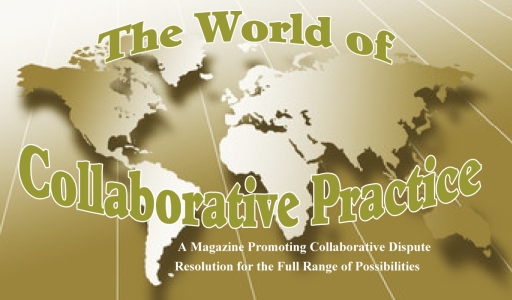
Tags
Related Posts
Share This
Collaborative Practice in Other than Divorce Matters
Sherrie Abney and Lawrence Maxwell share what’s been going on and where it can go.
Over twenty years ago a Minnesota family attorney, Stu Webb, created the collaborative dispute resolution process. Collaborative Law continues to progress nicely in the family arena.
Collaborative law is an exciting tool in the alternative dispute resolution tool box. The process enables individuals, families, businesses and organizations to maintain control over their relationships with others by empowering them with the ability to resolve their disputes peaceably. Why don’t more people use the collaborative process to resolve civil disputes?
For the past seven years the Global Collaborative Law Council and a number of organizations around the United States have been diligently working to expand the use of the collaborative dispute resolution process for resolving all types of civil disputes.
As we reflect on the progress, or lack of progress, of the civil collaborative movement, the writings of 19 th century philosopher and writer Henry David Thoreau come to mind.
“If you built castles in the sky; your work need not be lost;
that is where they should be.
Now, put the foundations under them.”
An analogy to the construction industry may be appropriate. Roger Fisher and William Ury (Getting to Yes,1981) leveled the construction site. Stu Webb came up with the plans (1990), and for the past several years collaborative professionals have been laying the foundation.
The world has been in need of a good form of dispute since Cain and Abel. However, the legal culture does not change overnight, and there are many tasks for us to accomplish in order to build a quality product that will be widely accepted by the legal profession and our client community.
Remember, the workers who lay foundations do not get much credit for the building. But, buildings will not stand without solid foundations. It is encouraging to review a few highlights of the foundation work over the past several years.
- 2000, the Massachusetts Collaboration Law Council was founded by Rita Pollak, David Hoffman and a group of like-minded lawyers in the Boston area.
- 2004, the Collaborative Council of the Redwood Empire was founded by Margaret “Peg” Anderson, Catherine Conner and a group of like-minded professionals in the San Francisco Bay area.
- 2004, the Texas Collaborative Law Council (now Global Collaborative Law Council) was founded by a group of Dallas attorneys committed to assisting clients in managing conflict and resolving disputes without litigation.
- 2005, GCLC developed Protocols of Practice and a Participation Agreement for Civil Collaborative Lawyers. Every year members of GCLC conduct trainings for lawyers and other professionals in civil collaborative law, nationally and internationally.
- 2005, Stu Webb and Canadian Marion Korn conduct the first Collaborative Law training in Australia. Today, practice groups are established in the Provinces of New South Wales, Queensland, Victoria, Western Australia and the Australian Capital Territory.
- 2005, Sherrie Abney authored the first book published on civil collaborative law: Avoiding Litigation: A Guide to Civil Collaborative Law.
- 2005, Robert Matlock, Sherrie Abney and Larry Maxwell were keynote speakers on collaborative law at a conference held at Oxford University by the ADR Group, the largest ADR organization in the United Kingdom.
- 2005, International Academy of Collaborative Professionals established a Civil Collaborative Practice Committee. Today, the organization counts members in all states in the U.S. and in twenty-five countries.
- 2006, the American Bar Association Section of Dispute Resolution created a Collaborative Law Committee. The ABA Collaborative Law Committee has developed a bold Mission Statement and created sub-committees and Liaisons to expand the understanding and use of the Collaborative Law process nationally and internationally.
- 2007, the American Bar Association Standing Committee on Ethics and Professional Responsibility issued Formal Opinion 07-477, which squarely supports Collaborative Law provided that the client has been informed about the benefits and risks of participating in the process and given his or her informed consent.
- 2008, at the 2 European Collaborative Law Conference in Cork, Ireland, sponsored by the IACP, Mary McAleese, President of the Republic of Ireland, opened the Conference by stating that Ireland has endorsed Collaborative Law as its first choice for dispute resolution.
- 2009, the Uniform Law Commission, by a unanimous vote, approved the Uniform Collaborative Law Act, which as of this date has been enacted in three states, and has been introduced in four states and the District of Columbia.
- 2009, in the Czech Republic, GCLC member Marie Brozova made a presentation on Collaborative Law to the International Conference of ADR.
- 2009, Kathy Bryan, President and CEO of the International Institute for Conflict Prevention & Resolution (CPR Institute) is keynote speaker at GCLC’s 6th Annual Civil Collaborative Law Training.
- 2009, the Kampala Law Society sponsored a Collaborative Law Training for lawyers, judges and law students at Uganda Christian University.
- 2010, in New Delhi, India at a conference of the Indo-American Chamber of Commerce, Collaborative Law was included in a presentation on international dealings and ways to stay out of foreign courts.
- 2010, Southern Methodist University Dedman School of Law established a three hour course in civil collaborative law, taught by Sherrie Abney, which is still being offered.
- 2011, the first textbook on civil collaborative law was published, authored by Sherrie Abney: Civil Collaborative Law: The Road Less Travelled.
- 2011, Presentation by Sherrie Abney at the Universidad de Ciencias Economicas y Sociales (University of Economic and Social Sciences) in Buenos Aires, Argentina. Lawyers in Buenos Aires have begun plans to incorporate the collaborative dispute resolution process into their practices.
- 2011, New York State Bar Association published an outstanding article supporting the Uniform Collaborative Law Act.
- 2011, The Collaborative Practice Professionals of Illinois present Sherrie Abney offering her 2-day training in Civil Collaborative Practice
- 2011, in November the first edition of The World of Collaborative Practice: A Magazine Promoting Collaborative Dispute Resolution for the Full Range of Possibilities, was published on-line by carl Michael rossi and Gloria Vanderhorst.
- Several states and local bar associations in the U.S. have established Collaborative Law Sections, which regularly conduct CLE programs.
- In Canada, collaborative practice is getting explicit recognition as a preferred option.
- The Province of Alberta has enacted, and several other Provinces are proposing legislation requiring lawyers to advise clients about the benefits of collaborative law before commencing actions in family law. A similar provision in all civil matters will be the next step.
- Collaborative Law organizations are developing pro bono programs to train collaborative professionals to work with Community Dispute Resolution Centers.
- Initiatives are underway to implement collaborative law principles in prestigious international organizations such as the Society of Trust & Probate Practitioners (STEP) and the World Intellectual Property Organization (WIPO).
- The U.S. State Department hosts visitors from other countries to tour several cities to gain knowledge of our legal system. During the visitors annual visit to Dallas, members of GCLC made presentations on the collaborative process.
- Articles are being published regularly in publications of the legal profession, trade association journals and local and national media.
The outstanding work of a number of dedicated individuals has created a solid foundation for civil collaborative law. The foundation is complete. Now, it is up to you to start building a unique edifice that will provide relief for clients that cannot be accomplished through adversarial processes.
Again, why don’t more people use the collaborative process to resolve civil disputes? The answer is simple. Not enough people know about collaborative law.
In our legal culture today, litigation is the First Option for resolving disputes. How do we make the collaborative process and other ADR processes the First Option? We need to educate the public as to the benefits of the collaborative process. Everyone who believes in the collaborative process needs to talk about the process at every opportunity: make presentations, write articles, post blogs. [See Woody Mosten’s thoughts on this here, ed.]
A collaborative colleague tells a wonderful story about a family trip to Morocco when he was a youth. The family went to a construction site where a castle was being built for the King of Morocco. They watched as a elderly craftsman sat cross legged and carved out very small pieces of colored mosaic tiles and put them on the wall, one by one. As the young boy watched he realized that it would take years to complete the castle and the craftsman would probably be dead before it was finished. His Dad said that the meticulous, time consuming and thankless labor of the worker will result in something so magnificent that it will be special and unique.
As collaborative professionals, we need to understand that anything that is truly unique takes time to build properly. Many dedicated lawyers and other professionals around the world truly believe the collaborative process is good for their clients, and that belief gives us assurance that the future of Collaborative Law is bright. Please talk to someone about Collaborative Law today, tomorrow and the next day. You’ll be amazed at how receptive people will be.
May the special gifts of health, peace, joy and happiness be yours throughout the New Year.
Lawrence R. Maxwell, Jr., President
Sherrie R. Abney, Vice-President
On behalf of the
Officers, Directors, Regional and Chapter Chairs
of the Global Collaborative Law Council
www.collaborativelaw.us









Share your thoughts here and in your network.